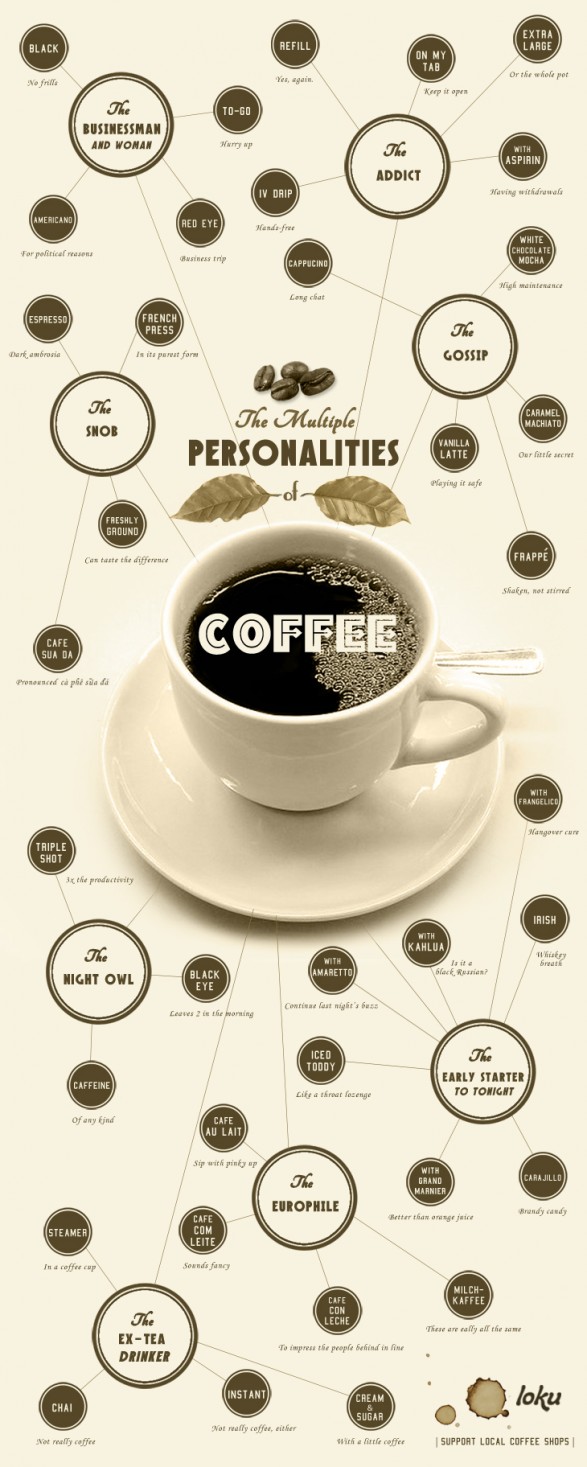

Create a new layer in this folder and name it Arrow Line.Ĭlick and hold the Shape tool (u) in your toolbar to see the flyout menu.
#Coffee infographic how to#
This is another thing I might normally draw in Illustrator, but let’s look at how to do it in Photoshop with a handy hidden arrow option.Ĭreate a new folder under the white coffee cup group and name it Coffee Currency. To change up the look a little bit and add more color, we’ll use a solid line with an arrow to divide the next section. With the folder selected, drag the coffee cup to the top left corner of the artboard so it overlaps the C in the title. Make sure the folder is the top group, above Textured Background. Now go back to your main layout file and you should see the coffee mug. In the pop-up window next to Document, select your main layout file (in this case, DC_CoffeeInfographic_PT_8fx14.psd) and click Ok. Click on the folder called Coffee in Black Mug with Plate.

Ok… it happens, but it doesn’t happen that often!įrom the freebies folder, open Freebies.psd. So, if you’re working on your own infographic (or any other piece for that matter), remember that no one just sits down and gets it right the first time. Although these steps seem smooth now, it’s important that you know it took a lot of fiddling to get all of the elements in place. To give the title copy a little more of that earthy feel, drag the Title folder below the Textured Gradient folder. If you’re substituting a different font that has lowercase letters, use the flyout menu on the top right of the Character palette to select All Caps. Although our overall look is clean and modern, I wanted the title to have an earthy feel that reflects our subject matter.Īlso note that this particular font is only available in all capital letters. I’m using one of the awesome fonts in this collection that comes with tons of variations – Tolyer X Vintage No1 at about 236 pt. It’s very inexact, but I’ll share my final settings with you if you want to match them.
#Coffee infographic free#
I just went to Edit > Free Transform and dragged my corners out (while holding shift) to get a size I liked and placed it at the top middle of the artboard. Select your Type tool (t) and type “coffee”. We’ll use this color for all of our title text. Then, go to your Swatch palette and click the new icon to Create a new swatch from foreground color. Create a new folder and name it (surprise!) Title.Ĭlick on your foreground color and change it to 163/58/36. In the Layers palette, change the Blend Mode to Multiply and our background is done. That’s the beauty of layer masks – nothing is ever truly gone! If you hide too much, just press D to toggle to white foreground color and brush over the area you want to show. If you don’t like your first attempt, don’t worry! You can keep dragging over it on the same layer until you’re happy with your result. With your Gradient Background layer selected, drag your gradient tool from the middle of the page to a little past the edge. To the right of the gradient, select the second icon for Radial Gradient. In the Properties menu at the top of the screen, click the arrow to the right of the gradient and make sure the gradient that goes from foreground color to background color is selected. Select the Gradient tool (or just press g). Do the same with the background color, but change the values to 68/25/16. Name this layer Gradient Background.Ĭlick on your foreground color below your tools and in the pop-up, change the RGB values to 109/52/40. In your Layers palette, click on the new layer icon. Let’s start by creating a gradient background. It will save you a ton of time and frustration!Īs always, save your file! Once saved, further saves require nothing more than hitting cmd/ctrl + s. The important thing is to find something consistent and easy for you to quickly identify and understand.
#Coffee infographic update#
If I get revisions, I’d update the revised file with r2.

So, this would be CoffeeInfographic_PT_8fx14_r1 (round 1). If I’m working with a client, I also add an abbreviation to indicate which round it is. This gives me all of the information I need to quickly identify a file without having to worry about some of the cross platform issues that can occur when you include periods, spaces or too many characters in filenames. A note about file naming: In this filename, I know I’m looking at the Coffee Infographic, a poster (PT – I have two-letter abbreviations for most of the common collateral types I work on), and the size is 8 and a fraction (f) by 14.


 0 kommentar(er)
0 kommentar(er)
